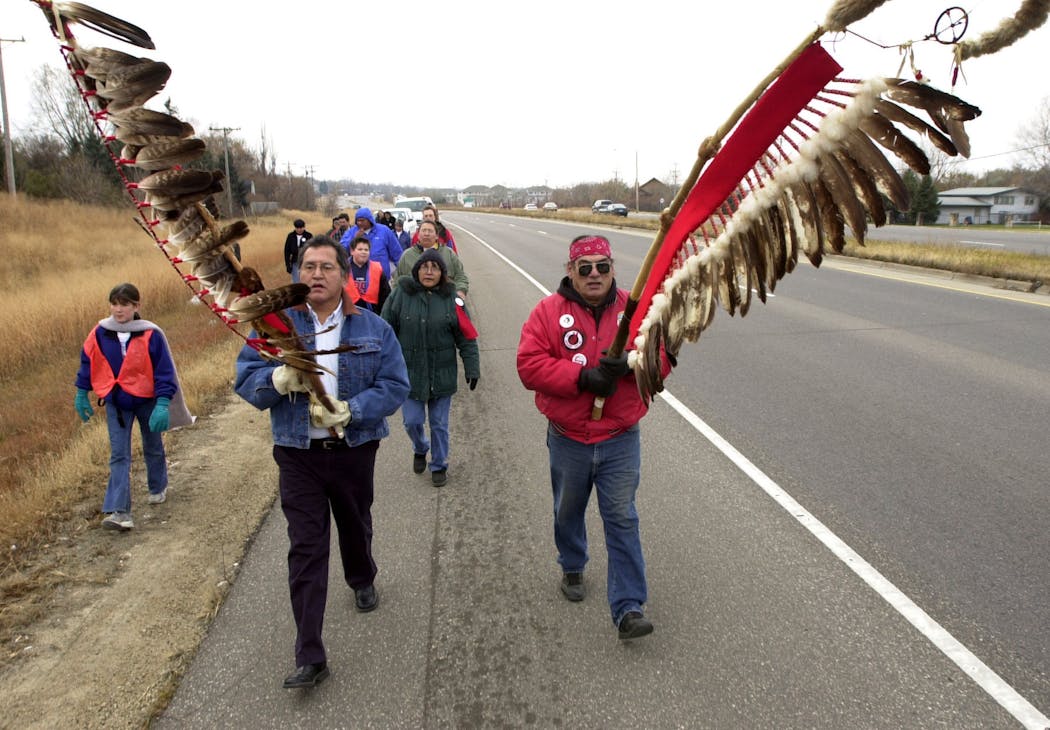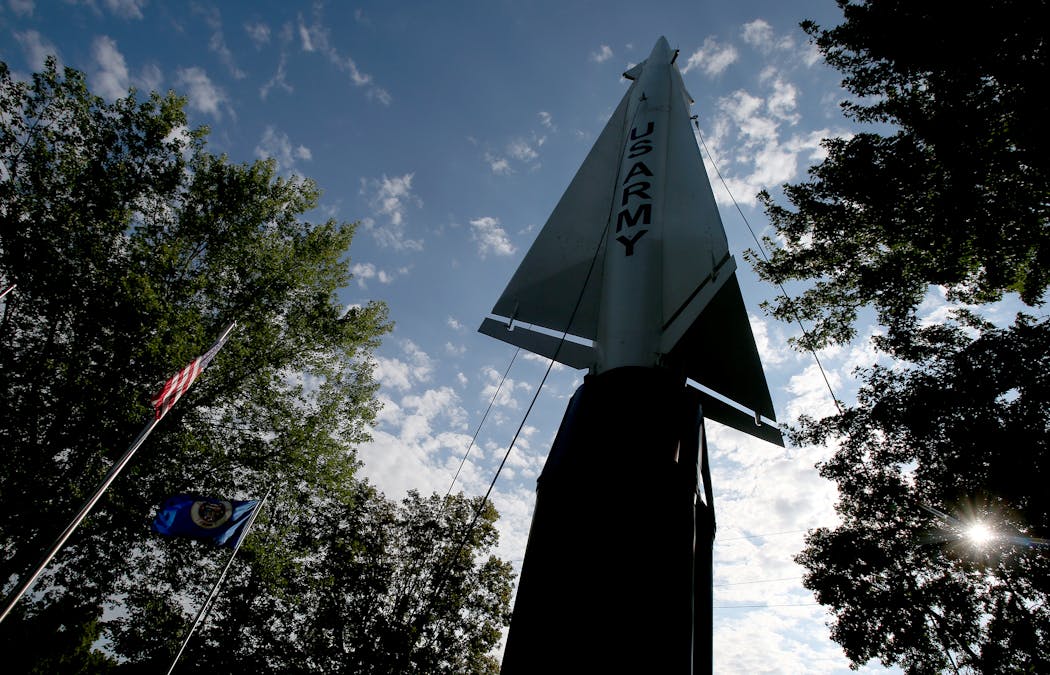There are memorials to the dead and the living, to fallen heroes and the victims of racism and ethnic cleansing.
What does it mean to memorialize a people or group, and who gets to tell that story?
The debate over the future of George Floyd Square in Minneapolis offers insight into how memorials can provide a space for reflection.
The giant metal fist symbolic of Black Liberation, with its red, black and green striped flag flying high, continues to stand tall over the intersection where Floyd was killed by a Minneapolis police officer.
The George Floyd Global Memorial organization wishes to maintain the site as a sacred spacewhere people can "grieve, pay respect and be a voice for justice." More than 3,000 offerings of street art, drawings by kids, protest signs, flowers, letters and other gifts remain at the intersection.
Meanwhile, old statues across the United States have come down as the nation debates its history of racial injustice and genocide.
In Duluth last fall, city officials helped install a historical marker at the site where three Black men were beaten, tortured and lynched a century ago after being wrongfully accused of raping a white woman. A memorial wall with three bronze sculptures representing the men was erected there in 2003.
Africa's Sankofa symbol — a bird with feet pointed forward and head turned back — suggests that we should learn from the past. Artist Esther Osayande created such a work for George Floyd Square, but says the piece is not a memorial, but "an acknowledgment, an alert. Important information for the future."
From Mankato to the heart of Minneapolis, here are several public art works that grapple with traumatic historical events.
Arthur & Edith Lee Family Memorial
In 1931, a Black couple and their daughter moved into their new home at 4600 Columbus Av. S., smack in the middle of an all-white neighborhood during the days of redlined Minneapolis. Mobs of white people — at times numbering up to 3,000 — harassed Arthur and Edith Lee, trying to drive them out. The Lees stayed for over a year, eventually moving 10 blocks north to a traditionally Black middle-class neighborhood.
Their resistance in the face of racism inspired Osayande and fellow artist Loretta Day to create a memorial in 2011 for the 80th anniversary. A steel plate depicting Arthur Lee now stands on the property next to a podium-like structure that tells the family's story of resistance.
"Lee, a postal worker and World War I vet, stood his ground for as long as he could without being killed," said Osayande, who worked in collaboration with the Black collective Obsidian Arts. "When you stand your ground on principle, that's a big statement. …
"This is a man who went to war and he works, but to that [white] community he was a nobody and didn't belong there. But he felt he did belong there, and had enough money to be there. He was there standing up to people with nooses, who wanted to hang them."
Fort Snelling
The U.S.-Dakota War of 1862 haunts Minnesota, particularly the aftermath at Fort Snelling, where 1,600 Dakota elders, women and children were imprisoned in what amounted to a concentration camp.
Forced to march there, more than 100 miles from the Lower Sioux reservation near Morton, Minn., they suffered physical abuse and were attacked by mobs of settlers. Many died during the journey, and at least 130 more in the winter months.
A memorial made of wooden beams, arranged in a circular configuration, was erected in 1987 on the river flats in front of the fort where the encampment once stood. At the center of the circle is a case containing pipestone and four sacred medicines. In front, a plaque labeled "Wokiksuye K'a Woyuonihan" ("Remembering and Honoring") tells the story of the place.
Additionally, the Minnesota Historical Society is in the early stages of a public artwork dedicated to Wakanozanzan and Sakpedan (also known as Medicine Bottle and Shakopee), two Dakota leaders who helped more than 500 Dakota refugees from the war. In 1865 they were captured, brought to Fort Snelling, and hanged.
"I think what needs to be better understood is that space is representative of the ultimate sacrifice of those two leaders who were hanged because of their participation in helping other leaders bring hundreds of Dakota elders, women and children to safety," said Kate Beane, director of Native American Initiatives at the Minnesota Historical Society.
Mankato memorials
On Dec. 26, 1862, 38 Dakota men were hanged in Mankato for their alleged participation in the war — still the largest mass execution in U.S. history.
Artist Thomas Miller, who is not Dakota but grew up in Mankato, saw an opportunity: "I always knew I was going to do something about the hangings of the Indians in my hometown."
His giant bison, carved from Kasota limestone with huge hoofs, two spiky horns and a furry mane, sits at the south end of what is now Reconciliation Park in downtown Mankato. "Winter Warrior," another Kasota sculpture depicting a Dakota man, is on nearby Riverfront Drive.
"Not many people were aware of what happened," he said. "Like water under the bridge, it was forgotten. Now it's at the forefront and you can't help but see it every day."
He said he worked on authentication with the late Amos Owen, a Prairie Island Mdewakanton elder who helped launch an annual powwow in Mankato as a means of reconciliation.
Miller is currently at work on a pair of stone moccasins, each 6 feet tall and weighing 300 pounds, that will go north of the bison. He isn't sure when they'll be done, because "they kind of have their own tempo," he said.
A trail of tragedy
Each year since 1987, Dakota men have run an overnight relay race from Fort Snelling to Mankato, ending at Land of Memories Park, where the powwow is held.
"It's a memorial, a way to remember and retrace," said Dakota writer/artist Gwen Westerman.
Similarly, the biennial Dakota Commemorative Walk, started in 2002, pays tribute to the women, children and elders who were forced to march to Fort Snelling.
"That's a whole lot more than just having a plaque," she said. "That is more the way that we have memorials. It is not a matter of creating something large and permanent, or small and permanent, to mark a spot. … It is active, not passive."
Decommissioned weaponry
Nearly every small town in Minnesota has one — an artillery piece, an empty tank, a grounded helicopter, often set in a manicured green area to remind townspeople of their neighbors who once fought in wars here or abroad.
In his project "Shrines: Public Weapons in America," artist/photographer Paul Shambroom has reconsidered these weapons that have been given second lives as memorials, tourist attractions, retail signage, playground equipment or historic artifacts.
"Why is a machine made for killing used as a memorial to the dead?" asks Shambroom, a professor at the University of Minnesota who investigates American history, culture and power through original and sourced imagery. "Does it help the community mourn and heal from its losses, or is it intended to inspire new generations of warriors? Can it do both?"
He photographed a Nike Hercules missile in St. Bonifacius that once was a "last resort" for protecting the Twin Cities in the event of a Soviet air attack. For vets who came of age during the Cold War, the memorial strikes a chord. For Shambroom, it poses a philosophical question.
Lorraine Motel sign
Artist Chris Larson rebuilt the sign from the Lorraine Motel in Memphis, where the Rev. Martin Luther King Jr. was assassinated, and put it in the middle of Minnesota, at Franconia Sculpture Park.
He considers the piece a sculpture, not a memorial.
"Although the Memphis Lorraine motel sign has become a signifier of remembrance, the sculpture revolves around its re-sited location and transporting and translating this conversation of race from the South to the North," he said. "There is remembering, but it's a different kind of remembering, more like recollection."
@AliciaEler • 612-673-4437
About 1 in 4 US adults over 50 say they expect to never retire, an AARP study finds
Music Review: St. Vincent's art-rock burns bright on seventh album, 'All Born Screaming'
Cristian Măcelaru to become music director of Cincinnati Symphony Orchestra in 2025-26
Italy bans loans of works to the Minneapolis Institute of Art in a dispute over an ancient statue




